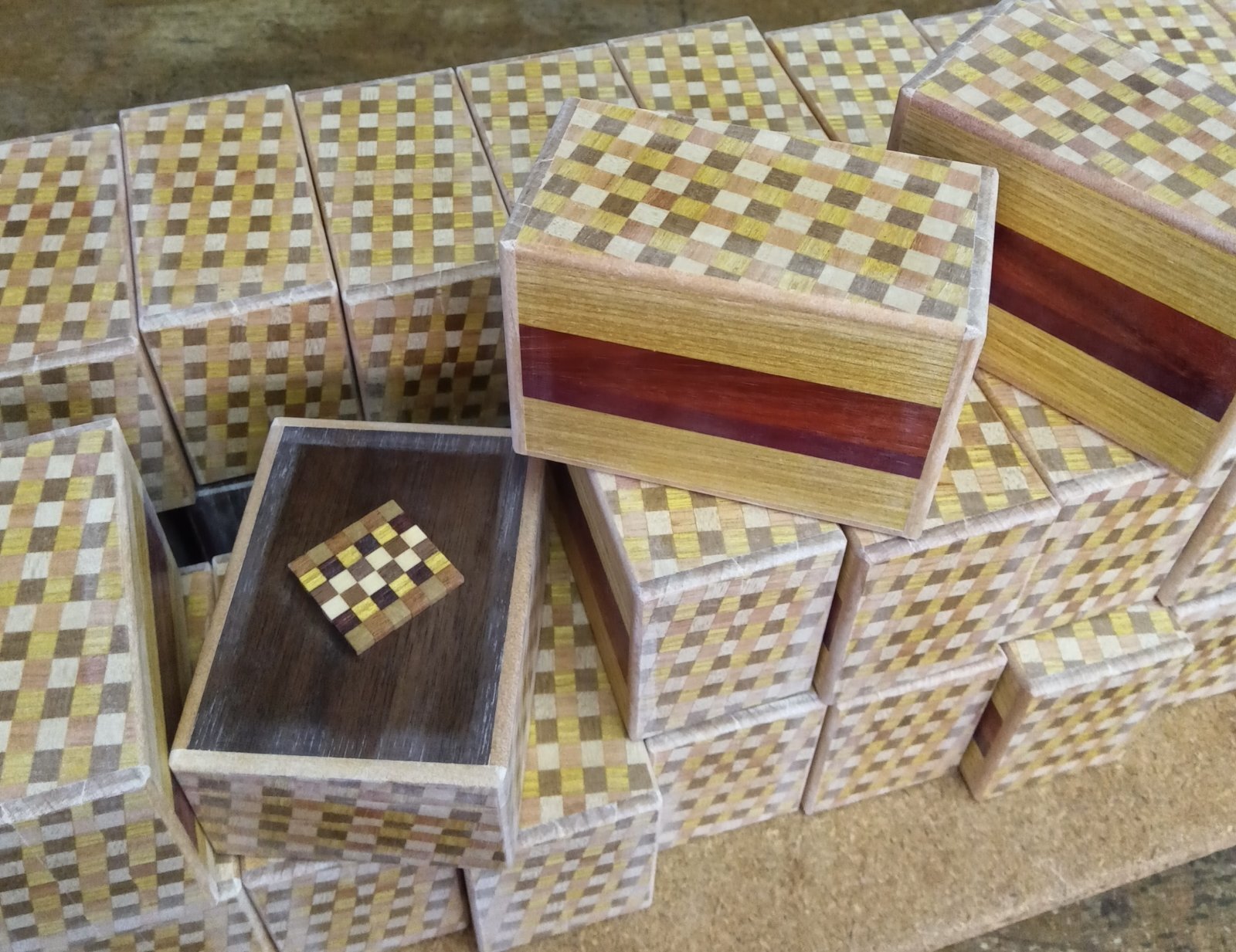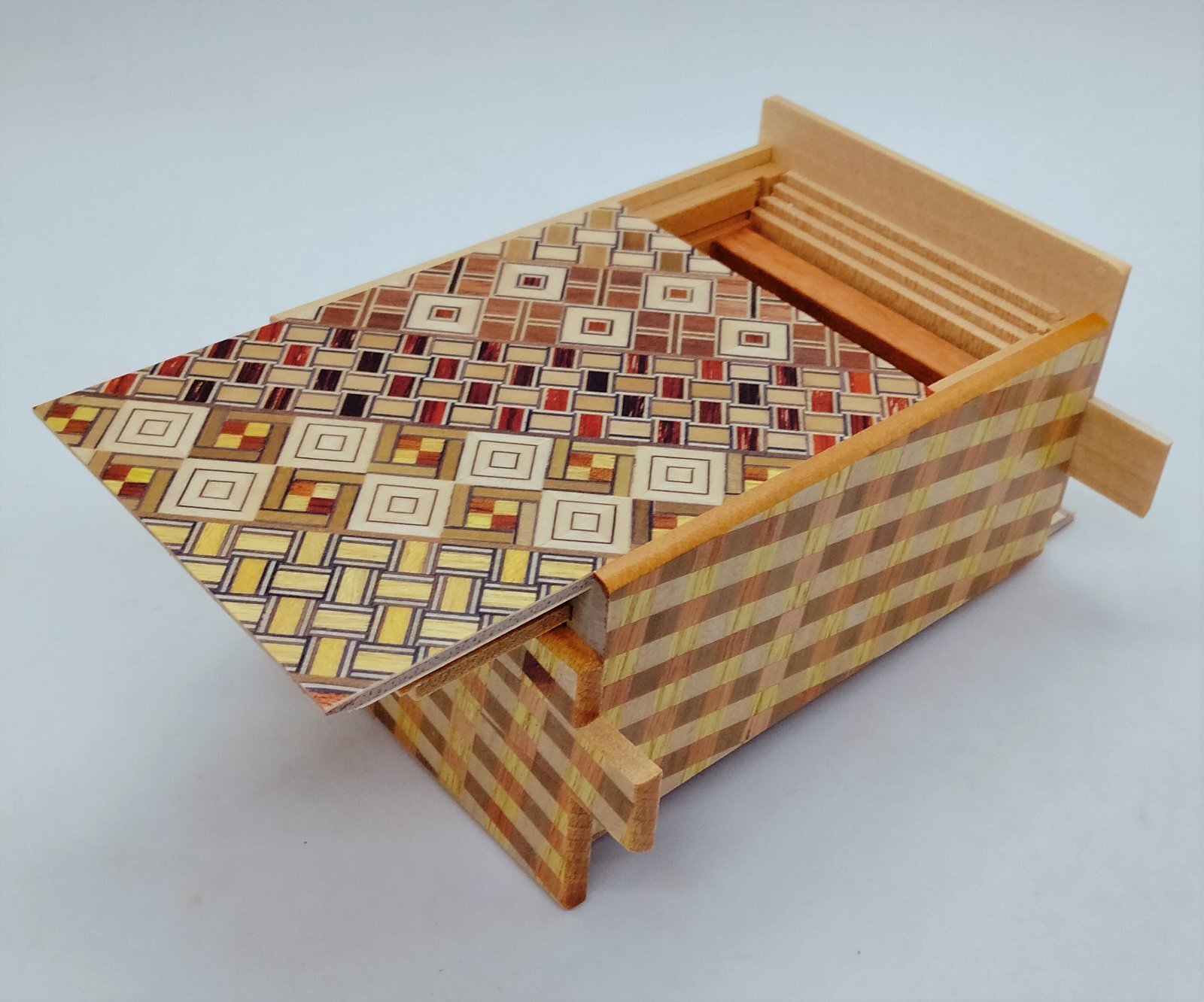coating of puzzle boxes
Today, I started with the 3-sun 12-steps puzzle boxes coat painting process. In the morning, I sanded the primed boxes with sandpaper, and in the afternoon, we applied the paint by spraying. As a result, I ended up producing three types of boxes, including six boxes featuring two types of one-point checkerboard yosegi (ichimatsu) design.
In addition, I repainted a few of the 4.2-sun boxes that were completed yesterday, as some had minor imperfections in the coating. The blemishes were so small that they were hardly noticeable, but solid wood boxes tend to show even the slightest scratches.
This is something often discussed among craftsmen in Hakone—while yosegi-zaiku (wooden mosaic work) is resistant to visible damage like scratches, solid wood boxes are more prone to showing imperfections. The intricate patterns of yosegi-zaiku help conceal small scratches, making them less noticeable.
Of course, ideally, there should be no scratches at all. However, since these are wooden products, minor scratches can sometimes occur during packaging or transportation. In this region, many manufacturers follow a division of labor system, where the painting process is handled by specialized coating companies. This means that if a box needs to be refinished, it has to be sent back to the coating company for repainting. Most coating companies, however, are reluctant to redo just one or few items.
In my workshop, all processes are handled in-house, allowing for immediate corrections when needed. This is extremely convenient. Fortunately, today’s work involved the final coating of the 3-sun boxes, so I was able to repaint these boxes together. For minor scratch repairs, all that’s needed is to spray the finishing coat once more.
After that, I began working on my next project: the 4-sun 27-step puzzle box. Yesterday, I had already rough-cut the materials to approximate dimensions. Today, I trimmed them to the precise required measurements.
As with most secret boxes, about five different types of materials are prepared for constructing the structural components. This doesn’t mean five different types of wood, but rather five different types of Agathis wood pieces, each with varying sizes and thicknesses. The first step is to adjust the thickness of these materials. Once that is done, they are cut to their respective dimensions, and the process of making the individual parts begins.
I plan to continue this process tomorrow.
In addition, I repainted a few of the 4.2-sun boxes that were completed yesterday, as some had minor imperfections in the coating. The blemishes were so small that they were hardly noticeable, but solid wood boxes tend to show even the slightest scratches.
This is something often discussed among craftsmen in Hakone—while yosegi-zaiku (wooden mosaic work) is resistant to visible damage like scratches, solid wood boxes are more prone to showing imperfections. The intricate patterns of yosegi-zaiku help conceal small scratches, making them less noticeable.
Of course, ideally, there should be no scratches at all. However, since these are wooden products, minor scratches can sometimes occur during packaging or transportation. In this region, many manufacturers follow a division of labor system, where the painting process is handled by specialized coating companies. This means that if a box needs to be refinished, it has to be sent back to the coating company for repainting. Most coating companies, however, are reluctant to redo just one or few items.
In my workshop, all processes are handled in-house, allowing for immediate corrections when needed. This is extremely convenient. Fortunately, today’s work involved the final coating of the 3-sun boxes, so I was able to repaint these boxes together. For minor scratch repairs, all that’s needed is to spray the finishing coat once more.
After that, I began working on my next project: the 4-sun 27-step puzzle box. Yesterday, I had already rough-cut the materials to approximate dimensions. Today, I trimmed them to the precise required measurements.
As with most secret boxes, about five different types of materials are prepared for constructing the structural components. This doesn’t mean five different types of wood, but rather five different types of Agathis wood pieces, each with varying sizes and thicknesses. The first step is to adjust the thickness of these materials. Once that is done, they are cut to their respective dimensions, and the process of making the individual parts begins.
I plan to continue this process tomorrow.

